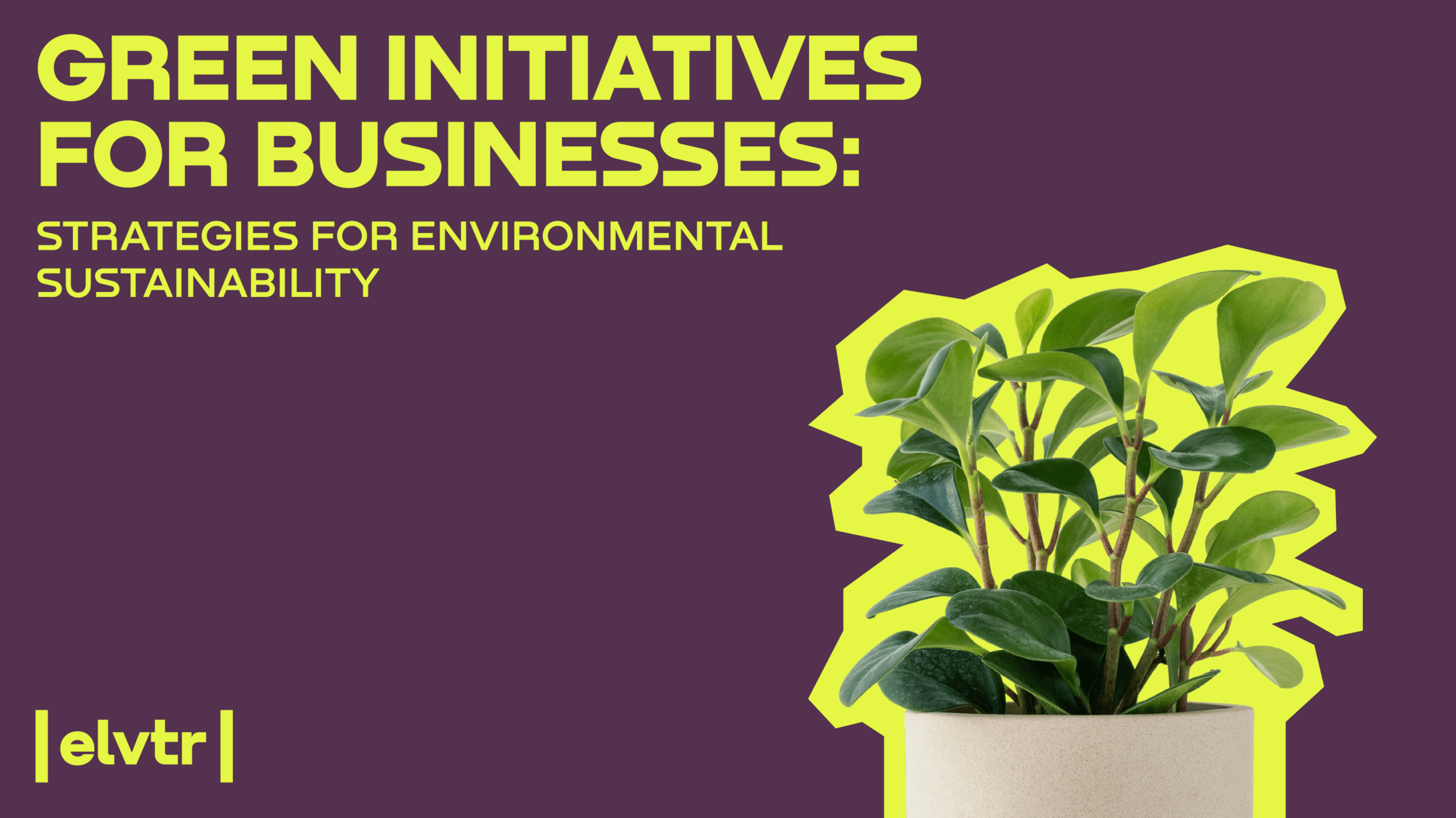- MAIN PAGE
- – elvtr magazine – THE IMPORTANCE OF SUSTAINABILITY STRATEGY IN BUSINESS: DRIVING ENVIRONMENTAL CHANGE
THE IMPORTANCE OF SUSTAINABILITY STRATEGY IN BUSINESS: DRIVING ENVIRONMENTAL CHANGE

Everyone’s talking about sustainability, but do businesses really make an effort to improve their environmental impact?
Let’s find out in this article. Here, we will discuss the importance of sustainability strategies and ways to implement them in your business.
Sustainability Strategy in Business
A sustainability strategy is a set of measures a business or organization takes to address environmental, social, and economic challenges. The primary goal of a sustainability strategy is to match an organization's operations, goals, and values with sustainable practices that make the world a better place.
Sometimes, companies might seem to spend a lot of money on sustainability initiatives and get nothing in return. But that is not true. A well-developed sustainability strategy hugely benefits a business, improving its reputation, profits, and innovational potential.
You can find more benefits of growing a sustainable business below:
- Cost savings. Your investment in sustainability can pay off. Environmental sustainability strategies often focus on reducing resource consumption, energy use, and waste production.
- Better efficiency. Optimization is one of the main perks of developing a sustainability strategy. You can find ways to streamline processes, optimize supply chains, and adopt more efficient technologies, reducing the business’s harmful environmental impact.
- Innovation. Sustainability efforts also drive innovation because businesses try to find or invent better solutions. This can lead to the development of unique offerings that differentiate the company from competitors.
- Customer loyalty. As more and more people become environmentally conscious, you can attract more customers and B2B clients.
- Reputation. Positive environmental impact improves brand perception and trust. At the same time, a company risks ruining its reputation if it fails to prioritize sustainability.
- Employee satisfaction. People are more motivated to work for a company that contributes positively to society. You can improve employee retention and satisfaction just by giving your employees a sense of belonging to a greater purpose.
- Investments. These days, investors are very likely to consider ESG (environmental, social, and governance) factors before they make a decision about your business. Having a sustainability strategy lined up will give you access to more investors and capital sources.
- Easier with rules. Environmental regulations become stricter each year, so you need to stay up to date. You instantly reduce legal and financial risks when you make sure that your business is sustainable.
Recommended courses
How Do Businesses Impact the Environment?
Let's start with the not-so-great part. Only 17% of goods are sustainable, while 78% of customers would prefer to live more sustainable lives.
Many businesses play rough with the environment. Imagine a factory that spews out lots of pollution into the air. Or think about a company that uses a ton of plastic and doesn't bother recycling. These businesses can harm the air, water, and land that we all share.
Some businesses are more conscious than others. For example, a restaurant that serves locally grown veggies and uses solar panels for power. Or a company that designs long-lasting products that you can use again and again. They can reduce waste, save energy, and be nice to nature.
The bigger the business, the more power it has to impact the environment and become a trendsetter in the corporate world. We’ve seen a lot of small eco-friendly local businesses, but are the big players really into this game?
All businesses, no matter at what scale they operate, leave carbon footprints. Eco-friendly initiatives became very popular in recent years, but you need to differentiate between driving actual change and simply creating an image.
While 90% of executives admit that sustainability is important, only 60% of the companies they work for actually have a sustainability strategy. Only 22.8% of Fortune 500 corporations work with the UN’s Sustainable Development Goals framework.
Remember, each business choice is like a move in this big game. And when they make smart moves, like using clean energy or cutting down on waste, they're scoring points for the planet.
How to Create a Sustainability Strategy?
Here's a simple guide on how to do it:
- Understand the impact of your business. Look at things like energy use, water consumption, waste production, and emissions. This helps you know where to focus your efforts.
- Decide what you want to achieve. It could be using less energy, reducing waste, or being more eco-friendly in your operations. Make sure your goals are specific and doable.
- Involve your team. They might have great ideas on how to be more eco-friendly. When everyone's on board, it's easier to make positive changes.
- Brainstorm green ideas and create a list of them. It could be using renewable energy sources, recycling more, or choosing sustainable materials. These ideas can be your action plan.
- Prioritize actions. Start small. Pick a few actions that have a big impact and are easy to do. You can add more actions as you go along.
- Create a timeline. Decide when you'll do each action. Set a timeline for making changes so you can track your progress.
- Allocate resources. Figure out what you need to make these changes happen. It could be money, time, or new equipment. Make sure you have what you need.
- Implement changes. Put your plan into action. Start making the changes you've decided on. Encourage everyone to follow the new practices.
- Monitor and measure. Keep an eye on how things are going. Are you using less energy? Are you producing less waste? Regularly check your progress to see if you're meeting your goals.
- Adapt and improve. Sometimes things might not go exactly as planned. That's okay! Learn from your experiences and adjust your strategy as needed. Improvement is part of the journey.
- Spread the word. Let your customers and the public know about your environmental efforts. People love supporting businesses that care about the planet, and it can also inspire others to do the same.
- Share stories. Share stories about your sustainability journey. It could be through social media, blog posts, or newsletters. This helps build a positive image and shows your commitment.
The Main Components of a Sustainability Strategy
Let’s imagine you need to assemble a puzzle. This part will also depend on the type and scale of the business. A big organization will need a huge puzzle with thousands of pieces that create a full picture. It would be much easier to deal with a smaller business as there are usually fewer variables and opportunities.
Here are the common parts of a sustainability strategy:
- Vision and goals. Just like a captain needs a map, a sustainability strategy starts with a clear vision and goals. This is where the business decides what it wants to achieve for a greener and better future.
- Assessment. Think of this as taking a snapshot of where the business is right now. The assessment helps figure out what's working and what needs to change.
- Stakeholder engagement. Businesses don't play alone. They need teammates like employees, customers, and communities. Stakeholder engagement is about talking to these teammates and listening to their ideas.
- Strategic initiatives. These are the specific actions the business plans to take. It could be using clean energy, reducing waste, or treating employees fairly.
- Integration into operations. Imagine fitting puzzle pieces together smoothly. Here, it's about making sustainability a part of how the business works every day and turning eco-friendly practices into habits.
- Metrics and reporting. Puzzle pieces need a frame to stay together. Metrics and reporting help measure progress, so the business knows if it's on track to complete the puzzle.
- Innovation and research. Innovation means coming up with new ideas, and research helps find smart ways to make them real.
- Risk management. Some puzzles have tricky pieces that need special attention. Risk management helps to figure out what could go wrong and have a plan to fix it.
- Collaboration and partnerships. Imagine joining your puzzle with a friend's to create a bigger picture. That's what collaboration and partnerships are like. Businesses team up with others to achieve even greater positive impact.
- Global goals alignment. Some puzzles are part of a bigger picture. In the same way, a business's sustainability strategy can align with global goals, like the United Nations Sustainable Development Goals, to contribute to a better world.
While this article comes to the finish line, the sustainability challenge is not likely to end in the foreseeable future. Responsible business practices hold an incredible potential to change the way we consume and even the way we live. Become a part of the power that drives businesses and communities towards a greener tomorrow and takes care of future generations.
Embrace the challenge of sustainability and watch as your actions create a masterpiece of positive change for both businesses and the planet.
*ELVTR is disrupting education by putting proven industry leaders in a virtual classroom with eager rising stars. ELVTR courses offer 100% instructor driven content designed to give you practical knowledge within a convenient time frame. Choose the right course for you!







